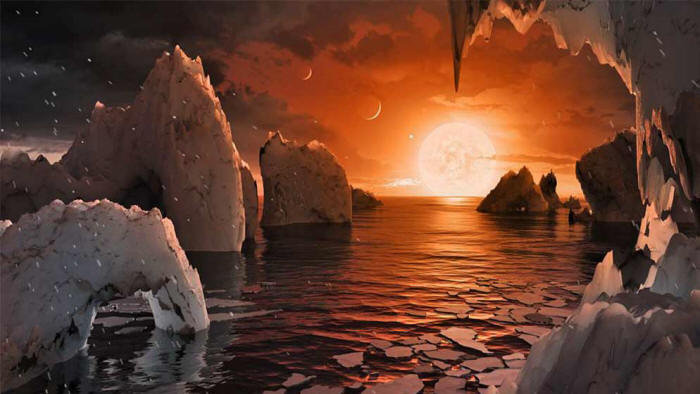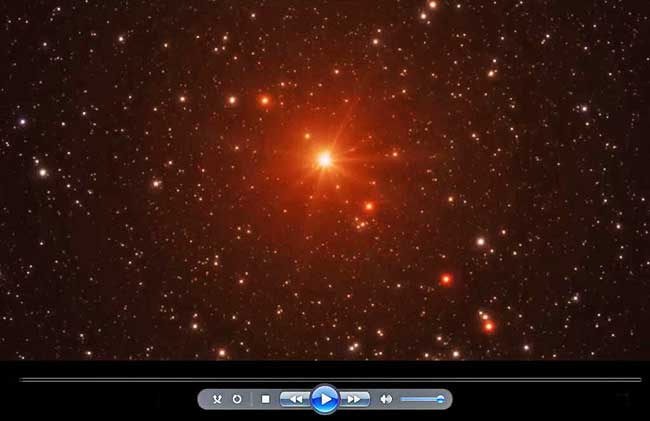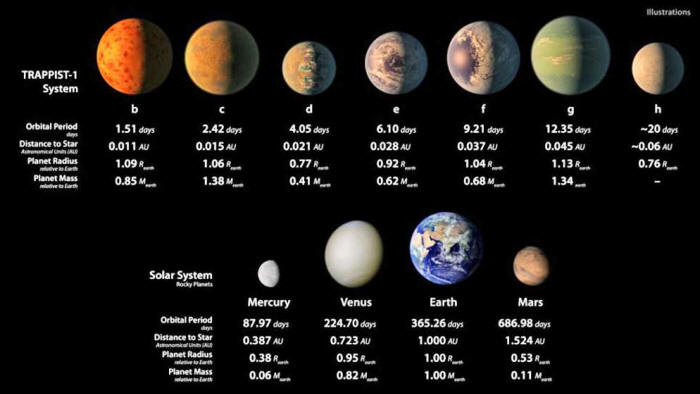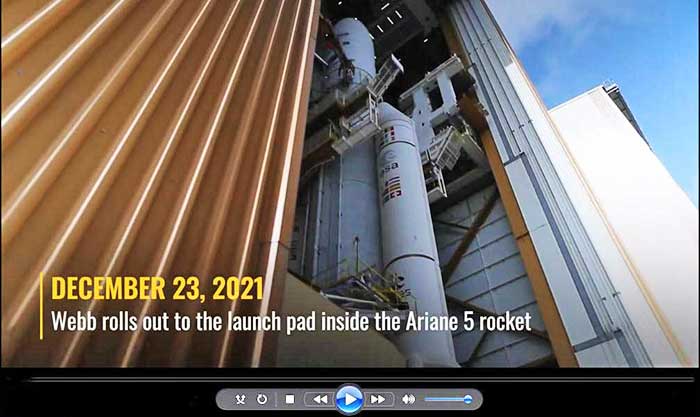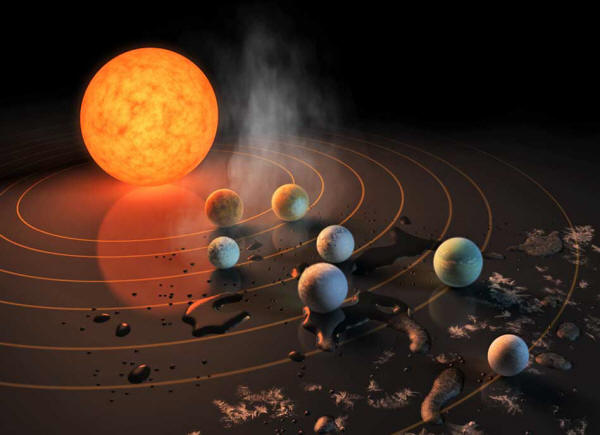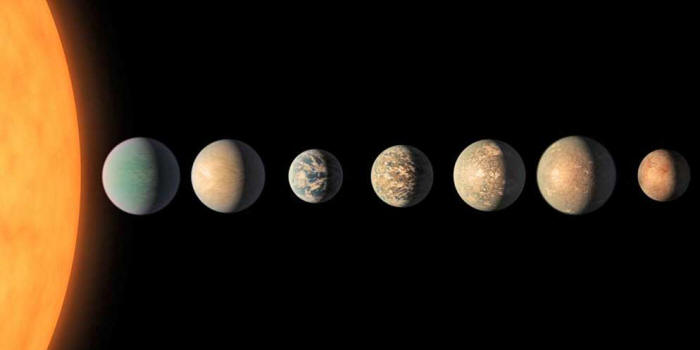|
exoplanet TRAPPIST-1f.
(Image
credit: NASA/JPL-Caltech) the truth about the seven planets in 'solar system 2.0'...?
Now look just to its right side and go 235 trillion miles (378 trillion kilometers) into the cosmos. Here between the head of Pisces and the side of Aquarius is a nondescript star called TRAPPIST-1, an ultra-cool red dwarf discovered in 1999.
The ultracool star TRAPPIST-1, located about 40 light-years from Earth, hosts at least seven exoplanets, most likely rocky worlds the size of Earth and smaller.
TRAPPIST-1 was mostly forgotten until 2017, when NASA announced that it hosted the most Earth-sized planets found in the habitable zone of a single star to date.
Exoplanet-hunters have been obsessed with TRAPPIST-1 ever since.
At last count, the neighborhood held seven planets, nearly matching the eight found in our own solar system.
NASA/JPL-Caltech compared to the rocky planets in our solar system.
Cue the James Webb Space Telescope (Webb or JWST), which exoplanet astronomers are hoping will reveal the true nature of this unique planetary system.
Using its ability to characterize an exoplanet's atmosphere, recently proven at WASP-96b, JWST is looking at each of the seven planets in its first year of operations, and we're on the cusp of the first results.
Revealing TRAPPIST-1A mere 39 light-years from Earth - a close neighbor in cosmic terms - the TRAPPIST-1 star is not sun-like.
The star is about a 10th of the sun's mass and about as wide as Jupiter. However, it's what orbits it that gets exoplanet-hunters excited.
Three planets were discovered in 2016 by a Belgian telescope at La Silla Observatory in Chile called TRAPPIST - the Transiting Planets and Planetesimals Small Telescope.
That discovery was more than confirmed by NASA's now-retired Spitzer Space Telescope in 2017.
Spitzer spent 1,000 hours staring at TRAPPIST-1 and was able to tell us that there were seven planets in the system.
Spitzer also measured both the mass and radius of each world, which allowed basic calculations of the planets' densities, all of which are similar to Earth's.
Astronomers have been on tenterhooks ever since.
Examining their atmospheres
Lewis co-led a team that in 2018 used the Hubble Space Telescope to scan the planets' atmospheres.
Such atmospheres are associated with gas giant planets like Saturn and Jupiter.
But Hubble had reached its limits. Cue JWST.
This artist's concept portrays TRAPPIST-1's seven rocky exoplanets. (Image credit: NASA-JPL/Caltech)
TRAPPIST-1 - A solar system 2.0?And astronomers have spent that time learning as much as possible about the seven TRAPPIST-1 worlds.
The TRAPPIST-1 system likely isn't much like the solar system.
Although four of the seven planets occupy the star's habitable zone - close enough to be warm enough to host liquid water - all orbit their star closer than Mercury does the sun.
Given that the star is much dimmer than our sun, that may not affect temperatures too much, but it drastically affects the conditions on the planets.
For example, the closest planet, TRAPPIST-1b, orbits its star in 1.9 Earth days. That's a very short year.
On TRAPPIST-1h, the farthest, a year takes just shy of 19 days. What's more, all of the planets are likely tidally locked, much like the moon is to Earth, so only one side ever gets daylight.
Despite these differences, TRAPPIST-1 remains the top exoplanet target for JWST because of its diversity of rocky planets.
And although it's one of the most-studied planetary systems, scientists still think TRAPPIST-1 has a lot more 'secrets' to reveal.
TRAPPIST-1 in transitTRAPPIST-1 the only star system we know with seven potentially Earth-like planets, but it's far from being the closest planetary system.
That honor goes to Proxima Centauri, at 4.24 light-years away from Earth.
So why the fascination with TRAPPIST-1, which is 10 times farther?
Our line of sight to the TRAPPIST-1 system is perfect, and our telescopes can see its seven planets crossing the disk of the star.
Astronomers can watch the TRAPPIST-1 planets go round and round.
This artist's concept shows what the TRAPPIST-1 planetary system may look like. (Image credit: NASA/JPL-Caltech)
JWST's first lookCan JWST find out what's in the atmospheres of these seven rocky exoplanets?
Webb's NIRSpec instrument makes it the only telescope capable of identifying the signatures of molecules such as methane, carbon dioxide and oxygen - possible signs of life on the surface and clues to the makeup of a planet's atmosphere.
After promising work decoding the gases present in the atmosphere of WASP-39b, last week astronomers finally got a glimpse of JWST's first look at the TRAPPIST-1 system.
It's not yet been peer-reviewed or published, but at a conference at JWST's HQ - the Space Telescope Science Institute in Baltimore - on Dec. 13, scientists discussed the telescope's initial data from its observations of TRAPPIST-1g, the second-farthest planet from the star.
Bj÷rn Benneke, an astronomer at the University of Montreal in Canada, showed that TRAPPIST-1g doesn't have a hydrogen-rich atmosphere.
Olivia Lim, a Ph.D. student at the University of Montreal, also presented a poster with similar results for TRAPPIST-1b (part of a reconnaissance program of all TRAPPIST-1 planets) as did Alexander Rathcke, an astronomer at the Harvard Smithsonian Center for Astrophysics, for observations of TRAPPIST-1c.
So, no headline-grabbing discoveries about any TRAPPIST-1 planets in JWST's first observations.
What's next for JWST?But don't be disheartened by the lack of revelations in these early results.
They're about reconnaissance - understanding how to best use JWST's precision and its various instruments.
Lewis will study TRAPPIST-1e.
Remember, this research is just about the planets' atmospheres.
But exoplanet science is not done in isolation.
Lewis is working with the University of Montreal because their observations of TRAPPIST-1d and TRAPPIST-1f - two of the other planets in the habitable zone - will together make for a fascinating comparative sample.
TRAPPIST-1's fundamental future
One of the TRAPPIST-1 planets will go down in history as hosting the first detected atmosphere of an Earth-size planet beyond our solar system.
The next few months, years and decades will see the TRAPPIST-1 system gradually revealed in exquisite detail.
But as well as finding out the true nature of its seven Earth-size planets, expect to see the neighborhood used to conduct some fundamental exoplanet science.
All of this opportunity comes from the incredible characteristics of a remarkably close star system.
|


